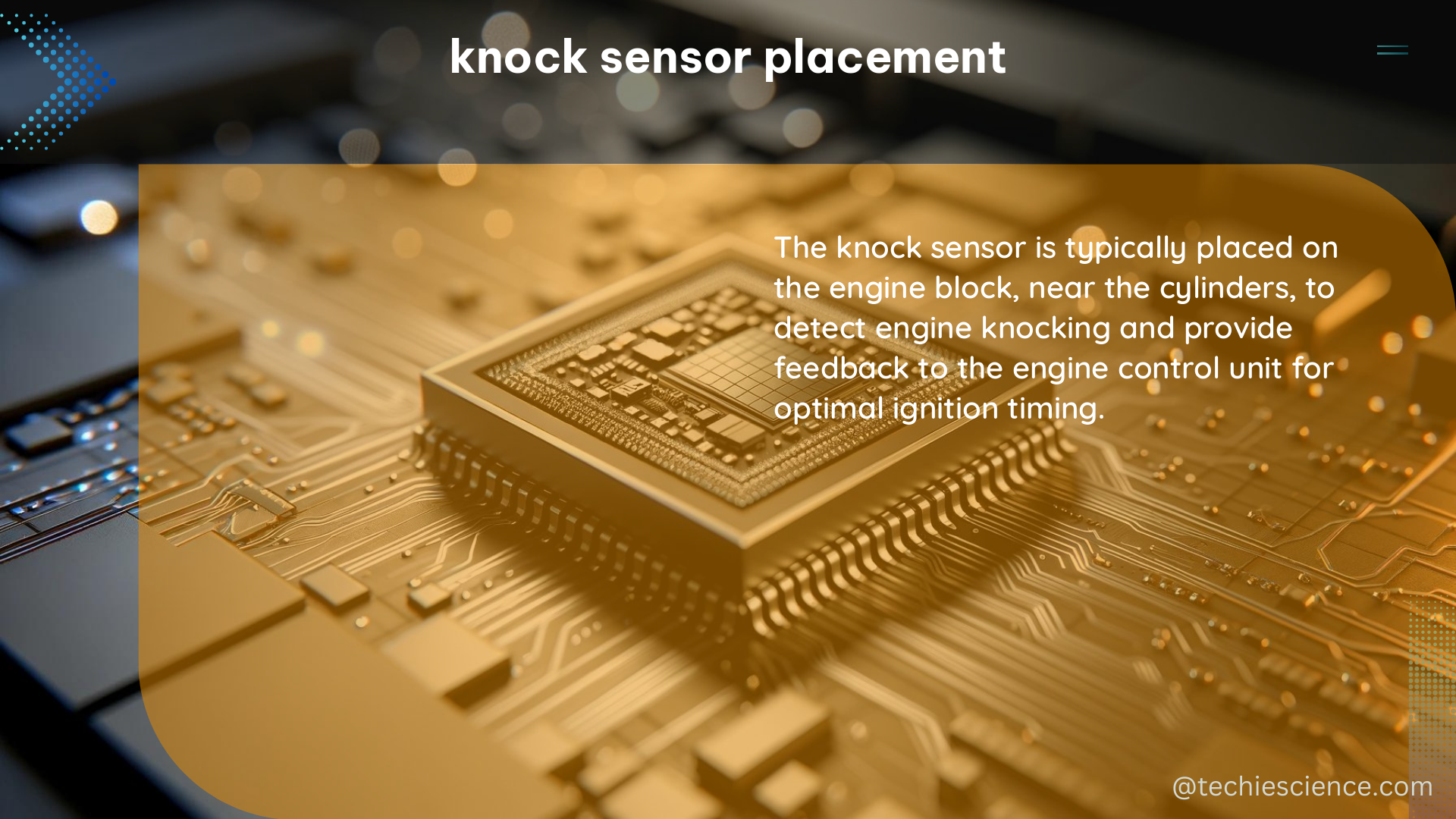Knock sensors are critical components in modern internal combustion engines, responsible for detecting engine knocking or detonation and adjusting ignition timing to prevent damage. The precise placement of these sensors is a crucial factor in their effectiveness, and it typically involves mounting them in the engine block or cylinder head, close to the combustion chamber. This comprehensive guide will delve into the intricacies of knock sensor placement, providing you with the technical details and best practices to ensure optimal engine performance.
Understanding Knock Sensors and Their Role
Knock sensors are piezoelectric devices that detect the high-frequency vibrations associated with engine knocking or detonation. When the air-fuel mixture in the combustion chamber ignites prematurely, it can cause a rapid pressure increase and a characteristic “knocking” sound. Knock sensors are strategically placed to monitor these vibrations and relay the information to the engine control unit (ECU), which then adjusts the ignition timing to prevent further knocking.
The effectiveness of knock sensors is directly related to their placement within the engine. Factors such as proximity to the combustion chamber, sensor orientation, and shielding from external vibrations all play a crucial role in the sensor’s ability to accurately detect and respond to engine knocking.
Optimal Knock Sensor Placement

Location
The most common placement for knock sensors is in the engine block or cylinder head, near the combustion chamber. This location allows the sensors to directly monitor the vibrations generated by knocking, ensuring a rapid and accurate response. Typical placement locations include:
-
Engine Block: Knock sensors are often mounted on the side of the engine block, close to the cylinder walls. This positioning allows the sensors to detect vibrations from multiple cylinders, providing a comprehensive view of the engine’s knocking behavior.
-
Cylinder Head: Alternatively, knock sensors can be placed in the cylinder head, directly above the combustion chamber. This placement offers a more localized monitoring of individual cylinders, potentially providing more precise knock detection.
Orientation
The orientation of the knock sensor is also crucial for optimal performance. Knock sensors are typically designed to be sensitive to vibrations in a specific direction, and their placement should align with this sensitivity axis. Common orientations include:
- Radial Orientation: Sensors are mounted with their sensitivity axis perpendicular to the engine block or cylinder head surface, allowing them to detect radial vibrations.
- Tangential Orientation: Sensors are positioned with their sensitivity axis parallel to the engine block or cylinder head surface, enabling them to detect tangential vibrations.
The choice of orientation depends on the specific engine design and the type of knock sensor being used. Consulting the manufacturer’s recommendations is essential to ensure the correct placement and orientation.
Shielding and Isolation
To ensure accurate knock detection, knock sensors must be shielded from external vibrations and noise sources. This is typically achieved through the use of:
- Mounting Brackets: Sturdy mounting brackets are used to securely attach the knock sensors to the engine block or cylinder head, minimizing the transmission of unwanted vibrations.
- Vibration Damping Materials: Rubber or other damping materials are often used between the sensor and the mounting surface to isolate the sensor from external vibrations.
- Electromagnetic Shielding: In some cases, the knock sensors may be enclosed in a shielded housing to protect them from electromagnetic interference (EMI) and other electrical noise.
Proper shielding and isolation of the knock sensors are crucial for maintaining their sensitivity and accuracy, ensuring reliable engine knock detection and ignition timing adjustments.
Sensor Selection and Calibration
The selection of the appropriate knock sensor is also an important consideration. Factors such as sensor sensitivity, frequency response, and temperature range should be carefully evaluated to match the specific requirements of the engine design. Manufacturers often provide guidance on the selection and compatibility of knock sensors for different engine models.
Additionally, the knock sensors must be properly calibrated to ensure accurate detection of engine knocking. This process typically involves adjusting the sensor’s sensitivity and response thresholds to match the engine’s specific characteristics and operating conditions. Proper calibration can be performed by experienced technicians or using specialized diagnostic tools.
Maintenance and Troubleshooting
Regular maintenance and monitoring of the knock sensors are essential to maintain their optimal performance. This includes:
- Periodic Inspection: Visually inspect the knock sensors for any signs of damage, such as cracks, corrosion, or loose connections.
- Sensor Replacement: Replace the knock sensors according to the manufacturer’s recommended service intervals or if any issues are detected.
- Diagnostic Checks: Regularly perform diagnostic checks to ensure the knock sensors are functioning correctly and providing accurate data to the ECU.
In the event of knock sensor-related issues, such as engine knocking, misfiring, or poor fuel efficiency, it is crucial to diagnose and address the problem promptly. This may involve troubleshooting the sensor’s electrical connections, checking for sensor failures, or recalibrating the system.
Conclusion
Knock sensor placement is a critical aspect of engine design, requiring a deep understanding of the sensor’s function, the engine’s vibration characteristics, and the specific requirements of the application. By following the best practices outlined in this comprehensive guide, you can ensure the optimal placement and performance of knock sensors, ultimately contributing to the overall reliability, efficiency, and longevity of your internal combustion engine.
References:
- FCC-15-9A1_Rcd.pdf
- Wireless E911 Location Accuracy Requirements
- Socio-Economic Benefits of Space Utilization

The lambdageeks.com Core SME Team is a group of experienced subject matter experts from diverse scientific and technical fields including Physics, Chemistry, Technology,Electronics & Electrical Engineering, Automotive, Mechanical Engineering. Our team collaborates to create high-quality, well-researched articles on a wide range of science and technology topics for the lambdageeks.com website.
All Our Senior SME are having more than 7 Years of experience in the respective fields . They are either Working Industry Professionals or assocaited With different Universities. Refer Our Authors Page to get to know About our Core SMEs.